1998 OPEL FRONTERA fuel pressure
[x] Cancel search: fuel pressurePage 1269 of 6000
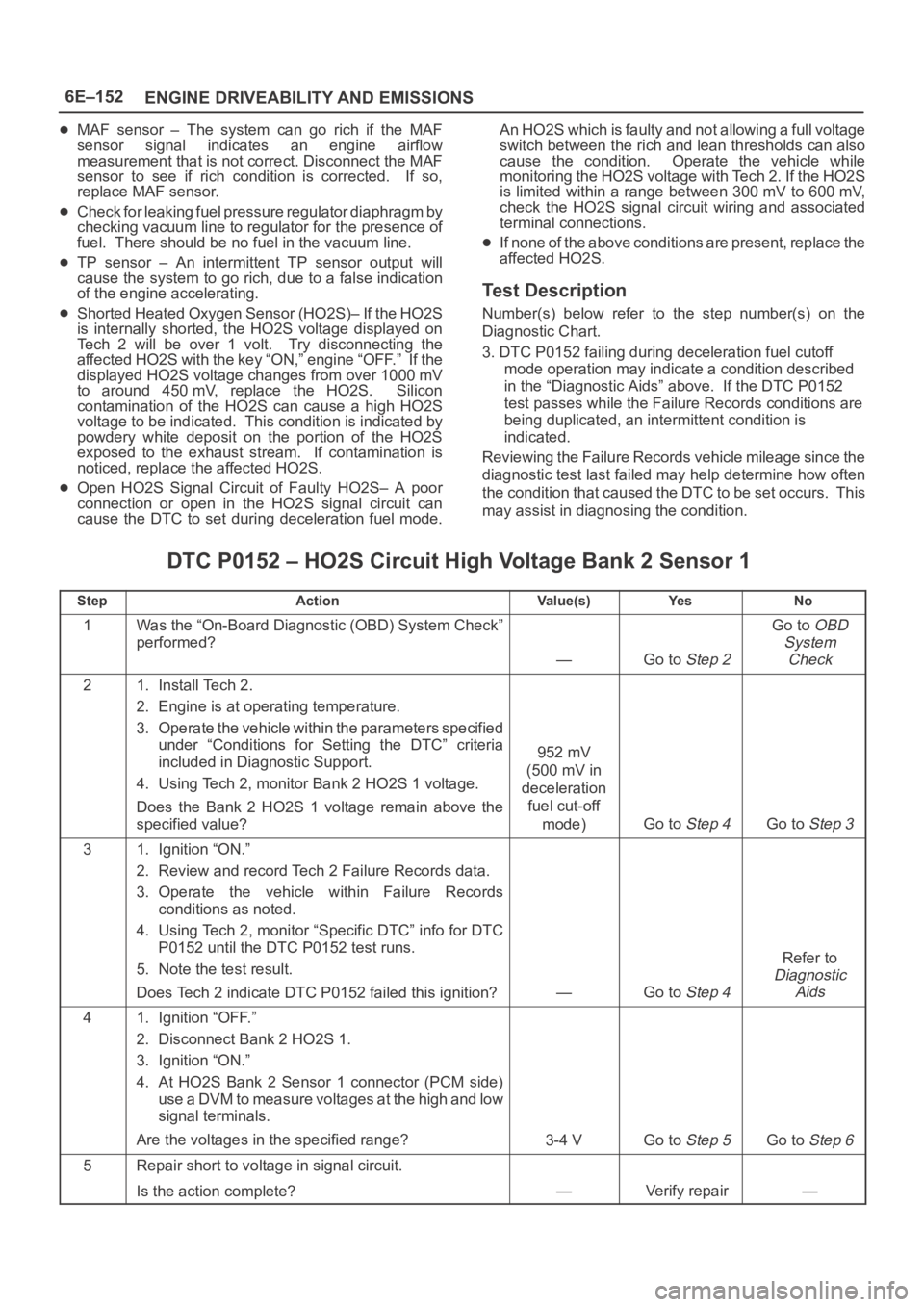
6E–152
ENGINE DRIVEABILITY AND EMISSIONS
MAF sensor – The system can go rich if the MAF
sensor signal indicates an engine airflow
measurement that is not correct. Disconnect the MAF
sensor to see if rich condition is corrected. If so,
replace MAF sensor.
Check for leaking fuel pressure regulator diaphragm by
checking vacuum line to regulator for the presence of
fuel. There should be no fuel in the vacuum line.
TP sensor – An intermittent TP sensor output will
cause the system to go rich, due to a false indication
of the engine accelerating.
Shorted Heated Oxygen Sensor (HO2S)– If the HO2S
is internally shorted, the HO2S voltage displayed on
Tech 2 will be over 1 volt. Try disconnecting the
affected HO2S with the key “ON,” engine “OFF.” If the
displayed HO2S voltage changes from over 1000 mV
to around 450mV, replace the HO2S. Silicon
contamination of the HO2S can cause a high HO2S
voltage to be indicated. This condition is indicated by
powdery white deposit on the portion of the HO2S
exposed to the exhaust stream. If contamination is
noticed, replace the affected HO2S.
Open HO2S Signal Circuit of Faulty HO2S– A poor
connection or open in the HO2S signal circuit can
cause the DTC to set during deceleration fuel mode.An HO2S which is faulty and not allowing a full voltage
switch between the rich and lean thresholds can also
cause the condition. Operate the vehicle while
monitoring the HO2S voltage with Tech 2. If the HO2S
is limited within a range between 300 mV to 600 mV,
check the HO2S signal circuit wiring and associated
terminal connections.
If none of the above conditions are present, replace the
affected HO2S.
Test Description
Number(s) below refer to the step number(s) on the
Diagnostic Chart.
3. DTC P0152 failing during deceleration fuel cutoff
mode operation may indicate a condition described
in the “Diagnostic Aids” above. If the DTC P0152
test passes while the Failure Records conditions are
being duplicated, an intermittent condition is
indicated.
Reviewing the Failure Records vehicle mileage since the
diagnostic test last failed may help determine how often
the condition that caused the DTC to be set occurs. This
may assist in diagnosing the condition.
DTC P0152 – HO2S Circuit High Voltage Bank 2 Sensor 1
StepActionVa l u e ( s )Ye sNo
1Was the “On-Board Diagnostic (OBD) System Check”
performed?
—Go to Step 2
Go to OBD
System
Check
21. Install Tech 2.
2. Engine is at operating temperature.
3. Operate the vehicle within the parameters specified
under “Conditions for Setting the DTC” criteria
included in Diagnostic Support.
4. Using Tech 2, monitor Bank 2 HO2S 1 voltage.
Does the Bank 2 HO2S 1 voltage remain above the
specified value?
952 mV
(500 mV in
deceleration
fuel cut-off
mode)
Go to Step 4Go to Step 3
31. Ignition “ON.”
2. Review and record Tech 2 Failure Records data.
3. Operate the vehicle within Failure Records
conditions as noted.
4. Using Tech 2, monitor “Specific DTC” info for DTC
P0152 until the DTC P0152 test runs.
5. Note the test result.
Does Tech 2 indicate DTC P0152 failed this ignition?
—Go to Step 4
Refer to
Diagnostic
Aids
41. Ignition “OFF.”
2. Disconnect Bank 2 HO2S 1.
3. Ignition “ON.”
4. At HO2S Bank 2 Sensor 1 connector (PCM side)
use a DVM to measure voltages at the high and low
signal terminals.
Are the voltages in the specified range?
3-4 VGo to Step 5Go to Step 6
5Repair short to voltage in signal circuit.
Is the action complete?
—Verify repair—
Page 1271 of 6000
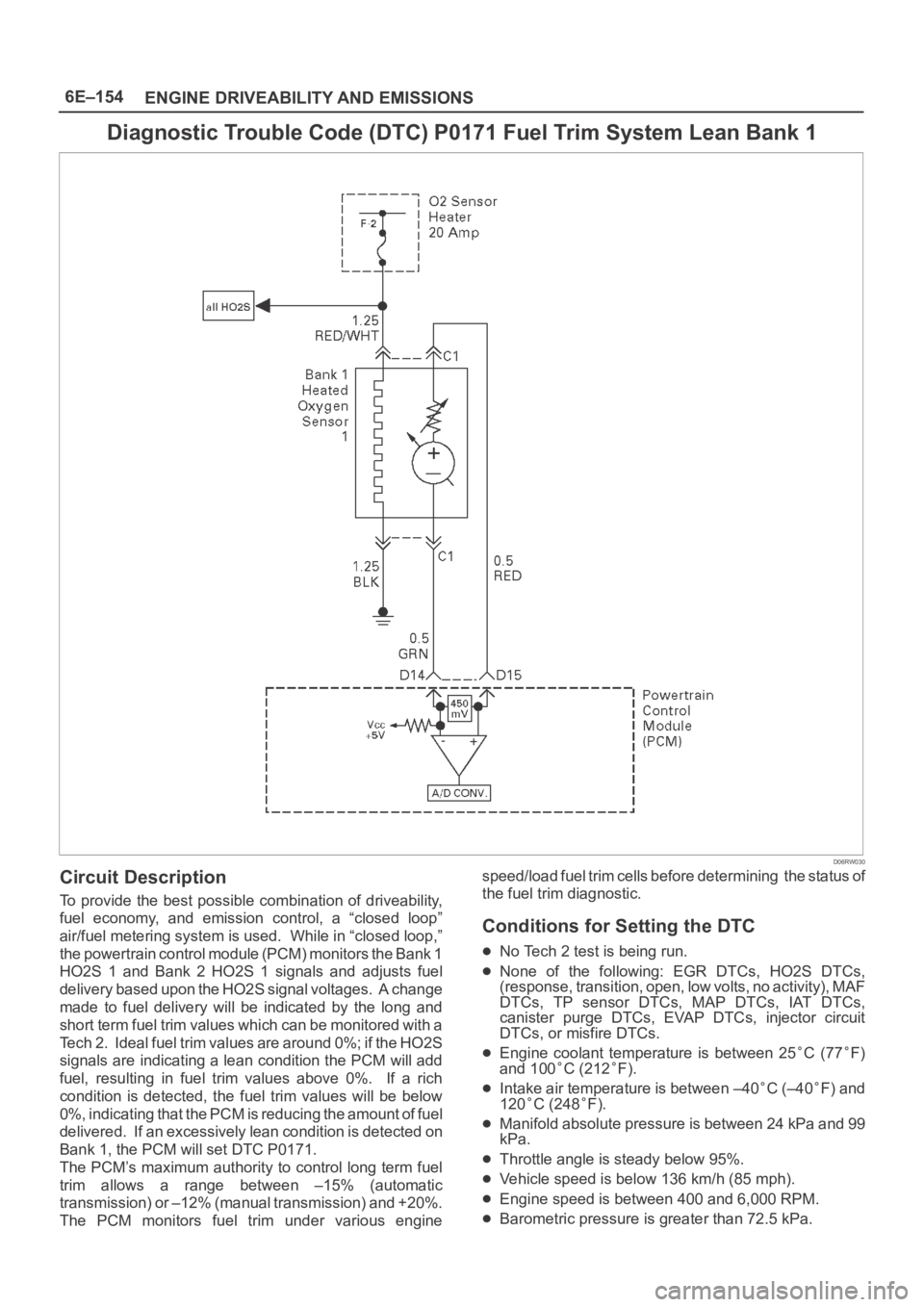
6E–154
ENGINE DRIVEABILITY AND EMISSIONS
Diagnostic Trouble Code (DTC) P0171 Fuel Trim System Lean Bank 1
D06RW030
Circuit Description
To provide the best possible combination of driveability,
fuel economy, and emission control, a “closed loop”
air/fuel metering system is used. While in “closed loop,”
the powertrain control module (PCM) monitors the Bank 1
HO2S 1 and Bank 2 HO2S 1 signals and adjusts fuel
delivery based upon the HO2S signal voltages. A change
made to fuel delivery will be indicated by the long and
short term fuel trim values which can be monitored with a
Tech 2. Ideal fuel trim values are around 0%; if the HO2S
signals are indicating a lean condition the PCM will add
fuel, resulting in fuel trim values above 0%. If a rich
condition is detected, the fuel trim values will be below
0%, indicating that the PCM is reducing the amount of fuel
delivered. If an excessively lean condition is detected on
Bank 1, the PCM will set DTC P0171.
The PCM’s maximum authority to control long term fuel
trim allows a range between –15% (automatic
transmission) or –12% (manual transmission) and +20%.
The PCM monitors fuel trim under various enginespeed/load fuel trim cells before determining the status of
the fuel trim diagnostic.
Conditions for Setting the DTC
No Tech 2 test is being run.
None of the following: EGR DTCs, HO2S DTCs,
(response, transition, open, low volts, no activity), MAF
DTCs, TP sensor DTCs, MAP DTCs, IAT DTCs,
canister purge DTCs, EVAP DTCs, injector circuit
DTCs, or misfire DTCs.
Engine coolant temperature is between 25C (77F)
and 100C (212F).
Intake air temperature is between –40C (–40F) and
120C (248F).
Manifold absolute pressure is between 24 kPa and 99
kPa.
Throttle angle is steady below 95%.
Vehicle speed is below 136 km/h (85 mph).
Engine speed is between 400 and 6,000 RPM.
Barometric pressure is greater than 72.5 kPa.
Page 1274 of 6000
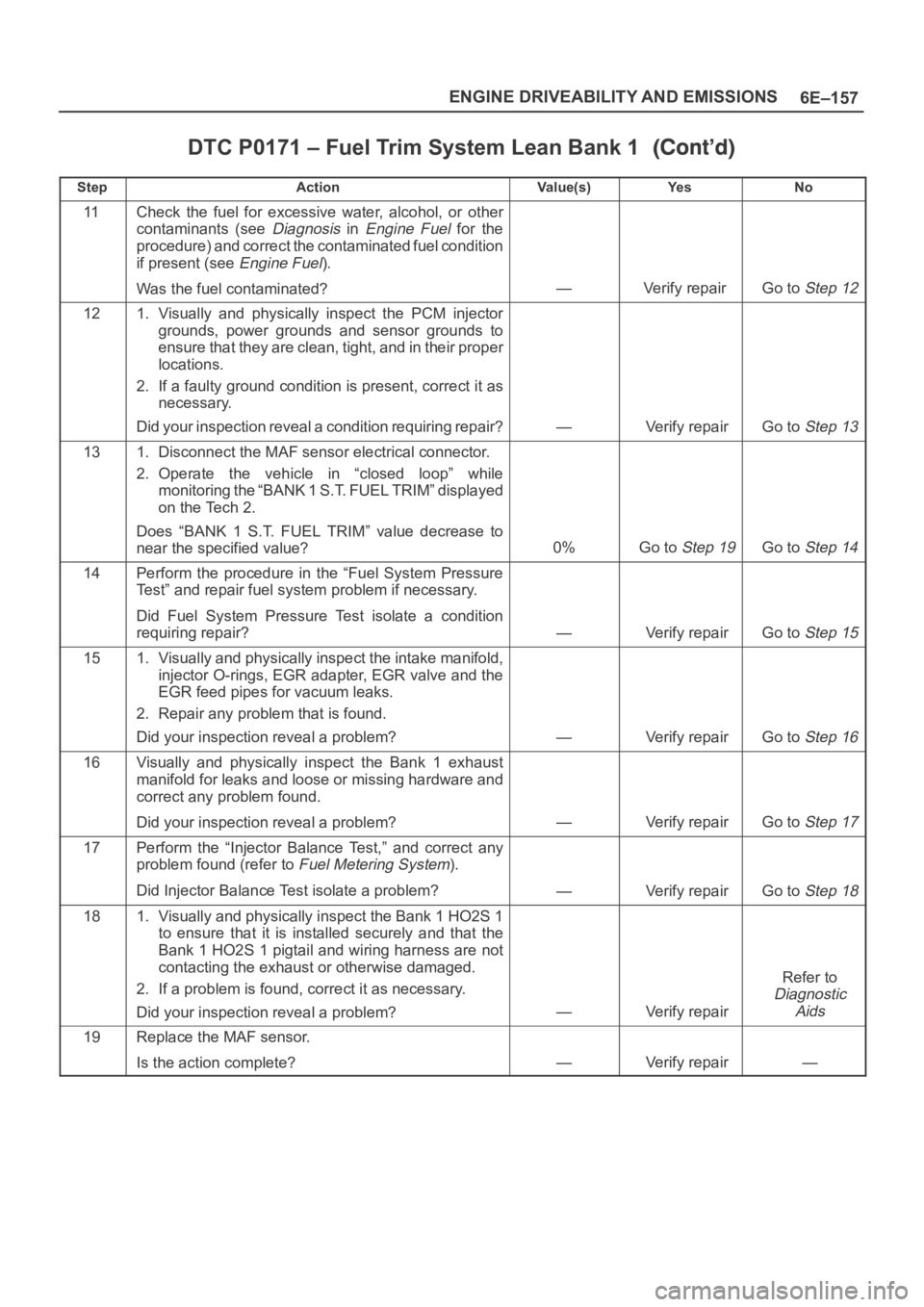
6E–157 ENGINE DRIVEABILITY AND EMISSIONS
DTC P0171 – Fuel Trim System Lean Bank 1
StepNo Ye s Va l u e ( s ) Action
11Check the fuel for excessive water, alcohol, or other
contaminants (see
Diagnosis in Engine Fuel for the
procedure) and correct the contaminated fuel condition
if present (see
Engine Fuel).
Was the fuel contaminated?
—Verify repair Go to Step 12
121. Visually and physically inspect the PCM injector
grounds, power grounds and sensor grounds to
ensure that they are clean, tight, and in their proper
locations.
2. If a faulty ground condition is present, correct it as
necessary.
Did your inspection reveal a condition requiring repair?
—Verify repairGo to Step 13
131. Disconnect the MAF sensor electrical connector.
2. Operate the vehicle in “closed loop” while
monitoring the “BANK 1 S.T. FUEL TRIM” displayed
on the Tech 2.
Does “BANK 1 S.T. FUEL TRIM” value decrease to
near the specified value?
0%Go to Step 19Go to Step 14
14Perform the procedure in the “Fuel System Pressure
Test” and repair fuel system problem if necessary.
Did Fuel System Pressure Test isolate a condition
requiring repair?
—Verify repairGo to Step 15
151. Visually and physically inspect the intake manifold,
injector O-rings, EGR adapter, EGR valve and the
EGR feed pipes for vacuum leaks.
2. Repair any problem that is found.
Did your inspection reveal a problem?
—Verify repairGo to Step 16
16Visually and physically inspect the Bank 1 exhaust
manifold for leaks and loose or missing hardware and
correct any problem found.
Did your inspection reveal a problem?
—Verify repairGo to Step 17
17Perform the “Injector Balance Test,” and correct any
problem found (refer to
Fuel Metering System).
Did Injector Balance Test isolate a problem?
—Verify repairGo to Step 18
181. Visually and physically inspect the Bank 1 HO2S 1
to ensure that it is installed securely and that the
Bank 1 HO2S 1 pigtail and wiring harness are not
contacting the exhaust or otherwise damaged.
2. If a problem is found, correct it as necessary.
Did your inspection reveal a problem?
—Verify repair
Refer to
Diagnostic
Aids
19Replace the MAF sensor.
Is the action complete?
—Verify repair—
Page 1275 of 6000
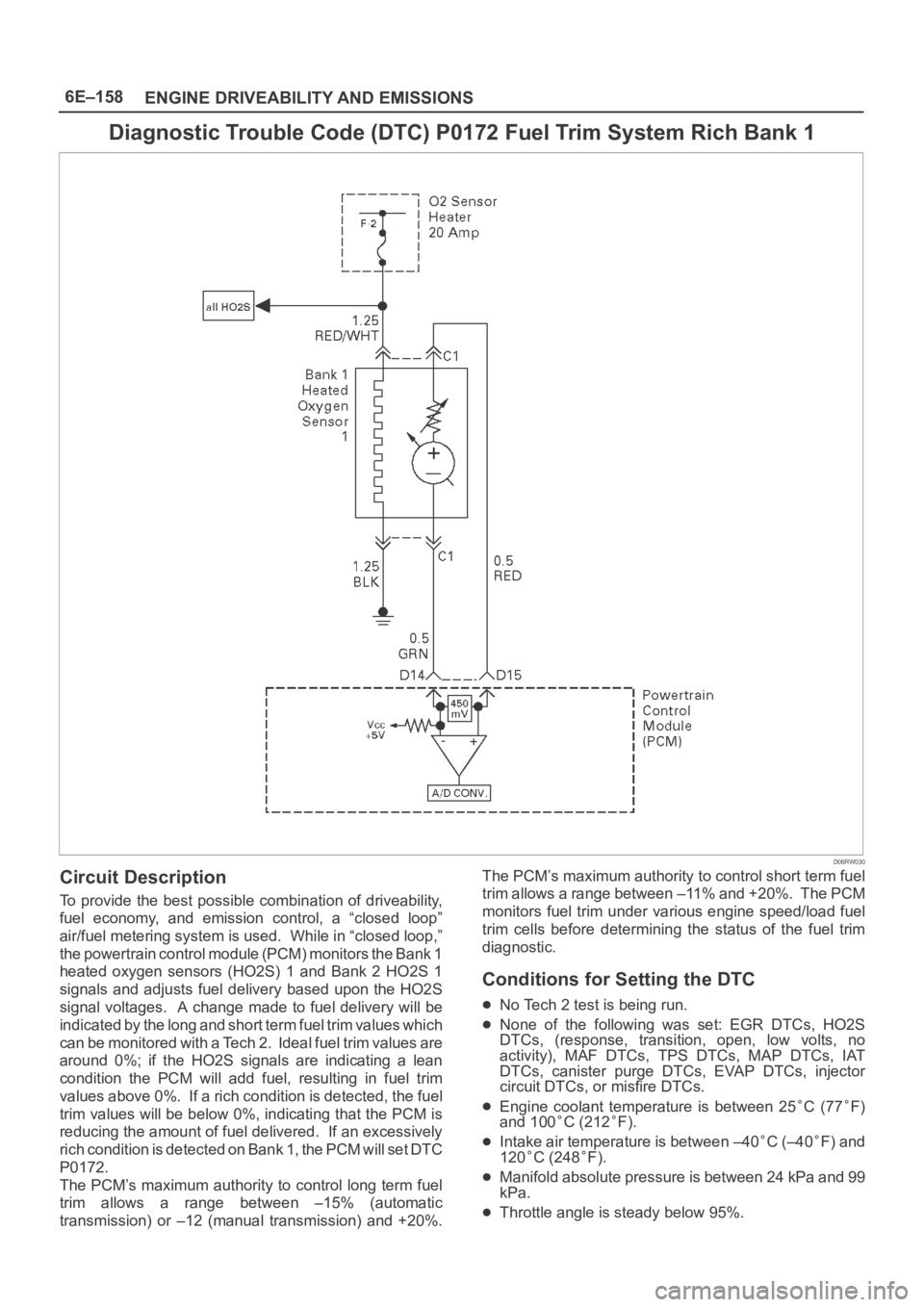
6E–158
ENGINE DRIVEABILITY AND EMISSIONS
Diagnostic Trouble Code (DTC) P0172 Fuel Trim System Rich Bank 1
D06RW030
Circuit Description
To provide the best possible combination of driveability,
fuel economy, and emission control, a “closed loop”
air/fuel metering system is used. While in “closed loop,”
the powertrain control module (PCM) monitors the Bank 1
heated oxygen sensors (HO2S) 1 and Bank 2 HO2S 1
signals and adjusts fuel delivery based upon the HO2S
signal voltages. A change made to fuel delivery will be
indicated by the long and short term fuel trim values which
can be monitored with a Tech 2. Ideal fuel trim values are
around 0%; if the HO2S signals are indicating a lean
condition the PCM will add fuel, resulting in fuel trim
values above 0%. If a rich condition is detected, the fuel
trim values will be below 0%, indicating that the PCM is
reducing the amount of fuel delivered. If an excessively
rich condition is detected on Bank 1, the PCM will set DTC
P0172.
The PCM’s maximum authority to control long term fuel
trim allows a range between –15% (automatic
transmission) or –12 (manual transmission) and +20%.The PCM’s maximum authority to control short term fuel
trim allows a range between –11% and +20%. The PCM
monitors fuel trim under various engine speed/load fuel
trim cells before determining the status of the fuel trim
diagnostic.
Conditions for Setting the DTC
No Tech 2 test is being run.
None of the following was set: EGR DTCs, HO2S
DTCs, (response, transition, open, low volts, no
activity), MAF DTCs, TPS DTCs, MAP DTCs, IAT
DTCs, canister purge DTCs, EVAP DTCs, injector
circuit DTCs, or misfire DTCs.
Engine coolant temperature is between 25C (77F)
and 100C (212F).
Intake air temperature is between –40C (–40F) and
120
C (248F).
Manifold absolute pressure is between 24 kPa and 99
kPa.
Throttle angle is steady below 95%.
Page 1276 of 6000
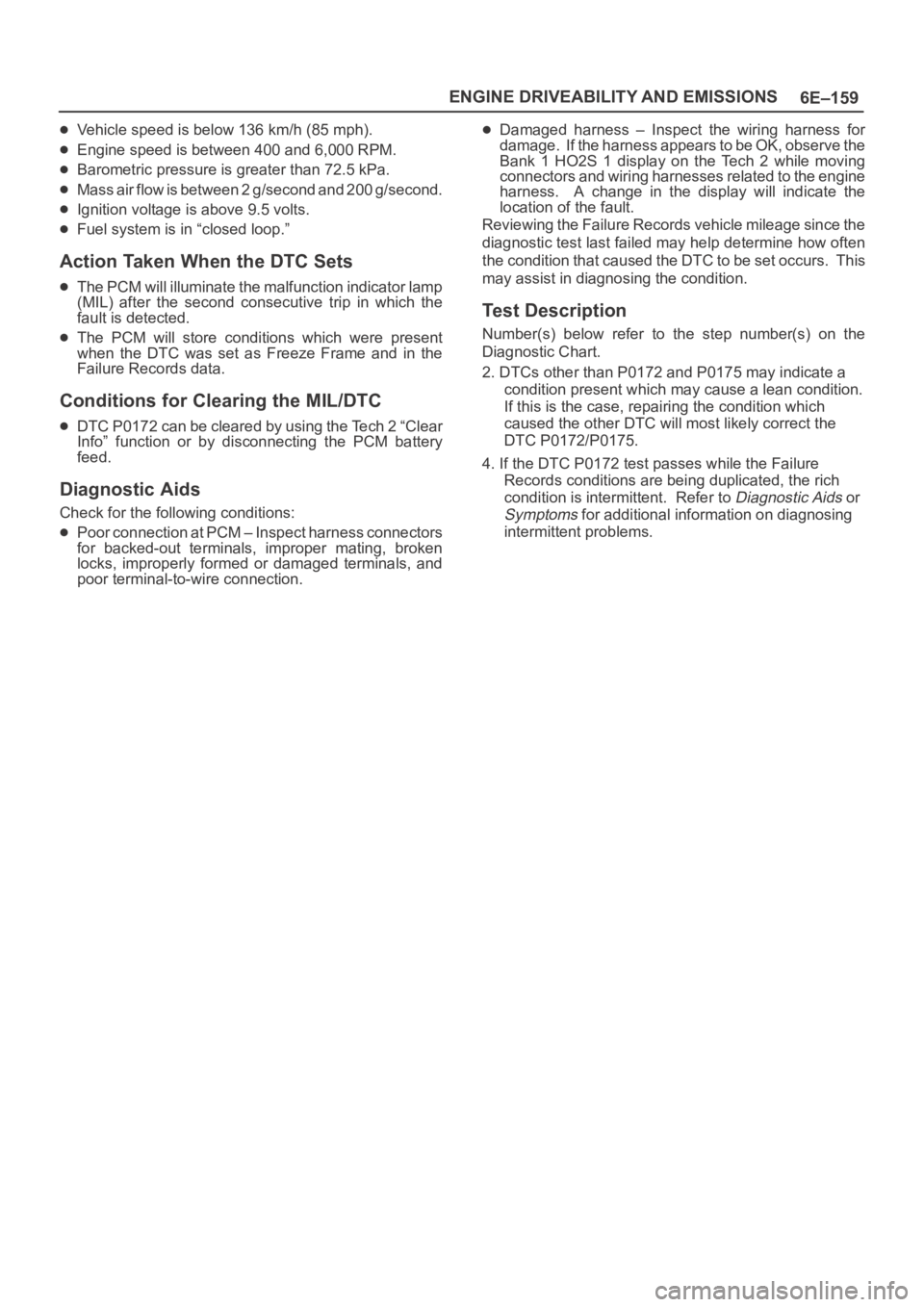
6E–159 ENGINE DRIVEABILITY AND EMISSIONS
Vehicle speed is below 136 km/h (85 mph).
Engine speed is between 400 and 6,000 RPM.
Barometric pressure is greater than 72.5 kPa.
Mass air flow is between 2 g/second and 200 g/second.
Ignition voltage is above 9.5 volts.
Fuel system is in “closed loop.”
Action Taken When the DTC Sets
The PCM will illuminate the malfunction indicator lamp
(MIL) after the second consecutive trip in which the
fault is detected.
The PCM will store conditions which were present
when the DTC was set as Freeze Frame and in the
Failure Records data.
Conditions for Clearing the MIL/DTC
DTC P0172 can be cleared by using the Tech 2 “Clear
Info” function or by disconnecting the PCM battery
feed.
Diagnostic Aids
Check for the following conditions:
Poor connection at PCM – Inspect harness connectors
for backed-out terminals, improper mating, broken
locks, improperly formed or damaged terminals, and
poor terminal-to-wire connection.
Damaged harness – Inspect the wiring harness for
damage. If the harness appears to be OK, observe the
Bank 1 HO2S 1 display on the Tech 2 while moving
connectors and wiring harnesses related to the engine
harness. A change in the display will indicate the
location of the fault.
Reviewing the Failure Records vehicle mileage since the
diagnostic test last failed may help determine how often
the condition that caused the DTC to be set occurs. This
may assist in diagnosing the condition.
Test Description
Number(s) below refer to the step number(s) on the
Diagnostic Chart.
2. DTCs other than P0172 and P0175 may indicate a
condition present which may cause a lean condition.
If this is the case, repairing the condition which
caused the other DTC will most likely correct the
DTC P0172/P0175.
4. If the DTC P0172 test passes while the Failure
Records conditions are being duplicated, the rich
condition is intermittent. Refer to
Diagnostic Aids or
Symptoms for additional information on diagnosing
intermittent problems.
Page 1278 of 6000
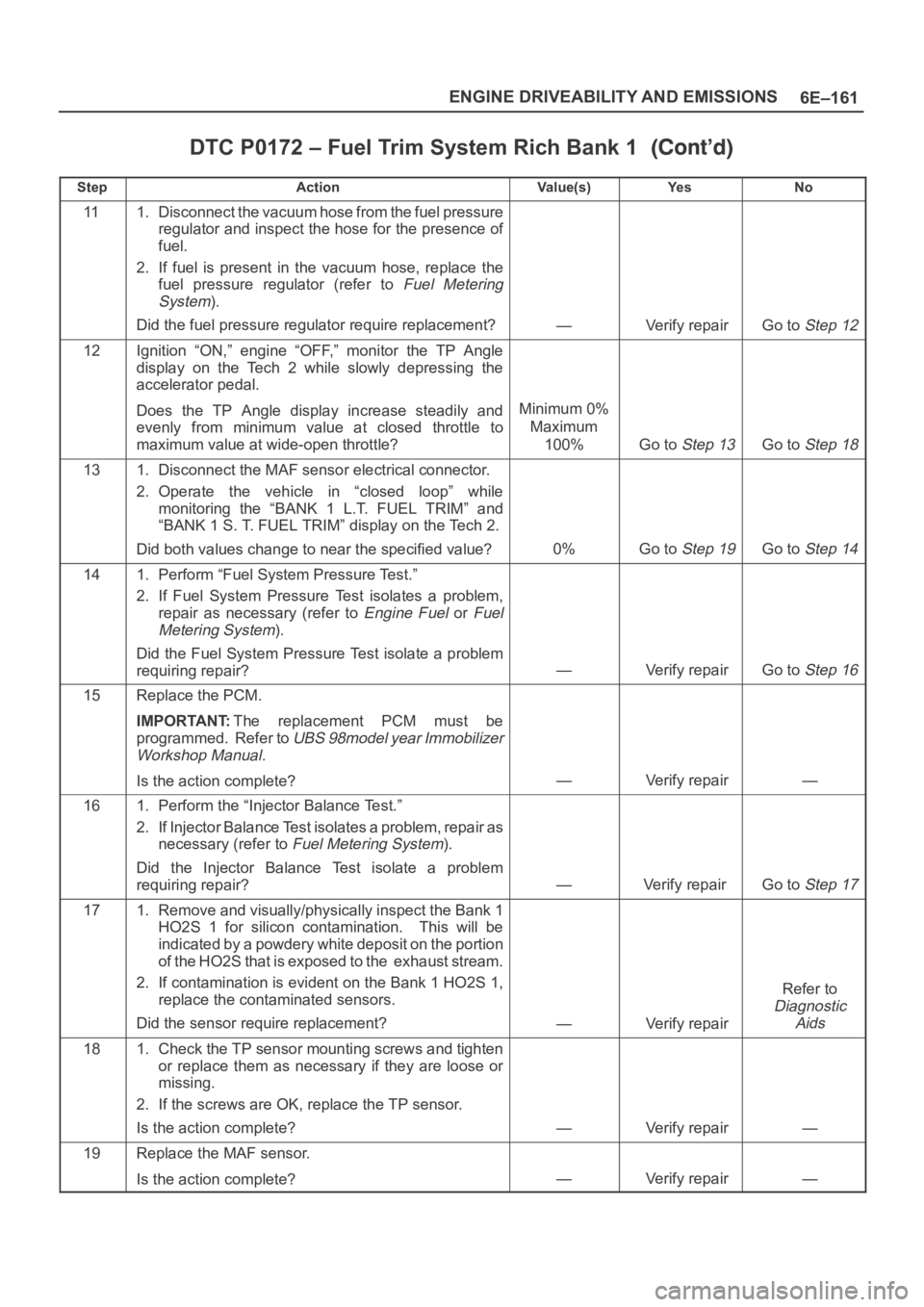
6E–161 ENGINE DRIVEABILITY AND EMISSIONS
DTC P0172 – Fuel Trim System Rich Bank 1
StepNo Ye s Va l u e ( s ) Action
111. Disconnect the vacuum hose from the fuel pressure
regulator and inspect the hose for the presence of
fuel.
2. If fuel is present in the vacuum hose, replace the
fuel pressure regulator (refer to
Fuel Metering
System
).
Did the fuel pressure regulator require replacement?
—Verify repairGo to Step 12
12Ignition “ON,” engine “OFF,” monitor the TP Angle
display on the Tech 2 while slowly depressing the
accelerator pedal.
Does the TP Angle display increase steadily and
evenly from minimum value at closed throttle to
maximum value at wide-open throttle?
Minimum 0%
Maximum
100%
Go to Step 13Go to Step 18
131. Disconnect the MAF sensor electrical connector.
2. Operate the vehicle in “closed loop” while
monitoring the “BANK 1 L.T. FUEL TRIM” and
“BANK 1 S. T. FUEL TRIM” display on the Tech 2.
Did both values change to near the specified value?
0%Go to Step 19Go to Step 14
141. Perform “Fuel System Pressure Test.”
2. If Fuel System Pressure Test isolates a problem,
repair as necessary (refer to
Engine Fuel or Fuel
Metering System
).
Did the Fuel System Pressure Test isolate a problem
requiring repair?
—Verify repairGo to Step 16
15Replace the PCM.
IMPORTANT:The replacement PCM must be
programmed. Refer to
UBS 98model year Immobilizer
Workshop Manual.
Is the action complete?—Verify repair—
161. Perform the “Injector Balance Test.”
2. If Injector Balance Test isolates a problem, repair as
necessary (refer to
Fuel Metering System).
Did the Injector Balance Test isolate a problem
requiring repair?
—Verify repair Go to Step 17
171. Remove and visually/physically inspect the Bank 1
HO2S 1 for silicon contamination. This will be
indicated by a powdery white deposit on the portion
of the HO2S that is exposed to the exhaust stream.
2. If contamination is evident on the Bank 1 HO2S 1,
replace the contaminated sensors.
Did the sensor require replacement?
—Verify repair
Refer to
Diagnostic
Aids
181. Check the TP sensor mounting screws and tighten
or replace them as necessary if they are loose or
missing.
2. If the screws are OK, replace the TP sensor.
Is the action complete?
—Verify repair—
19Replace the MAF sensor.
Is the action complete?
—Verify repair—
Page 1279 of 6000

6E–162
ENGINE DRIVEABILITY AND EMISSIONS
Diagnostic Trouble Code (DTC) P0174 Fuel Trim System Lean Bank 2
D06RW031
Circuit Description
To provide the best possible combination of driveability,
fuel economy, and emission control, a “closed loop”
air/fuel metering system is used. While in “closed loop,”
the powertrain control module (PCM) monitors the Bank 1
HO2S 1 and Bank 2 HO2S 1 signals and adjusts fuel
delivery based upon the HO2S signal voltages. A change
made to fuel delivery will be indicated by the long and
short term fuel trim values which can be monitored with a
Tech 2. Ideal fuel trim values are around 0%; if the HO2S
signals are indicating a lean condition the PCM will add
fuel, resulting in fuel trim values above 0%. If a rich
condition is detected, the fuel trim values will be below
0%, indicating that the PCM is reducing the amount of fuel
delivered. If an excessively lean condition is detected on
Bank 2, the PCM will set DTC P0174.
The PCM’s maximum authority to control long term fuel
trim allows a range between –15%(automatic
transmission) or –12%(manual transmission) and +20%.
The PCM monitors fuel trim under various enginespeed/load fuel trim cells before determining the status of
the fuel trim diagnostic.
Conditions for Setting the DTC
No Tech 2 test is being run.
None of the following DTCs are set: idle system, EGR,
HO2S, (response, transition, open, low volts, no
activity), MAF, TP sensor, MAP, IAT, canister purge,
EVAP, injector circuit, or misfire.
Engine coolant temperature is between 25C (77F)
and 100C (212F).
Intake air temperature is between –40C (–40F) and
120C (248F).
Manifold absolute pressure is between 24 kPa and 99
kPa.
Throttle angle is steady below 95%.
Vehicle speed is below 136 km/h (85 mph).
Engine speed is between 400 and 6,000 RPM.
Barometric pressure is greater than 72.5 kPa.
Mass air flow is between 2 g/second and 200 g/second.
Page 1282 of 6000
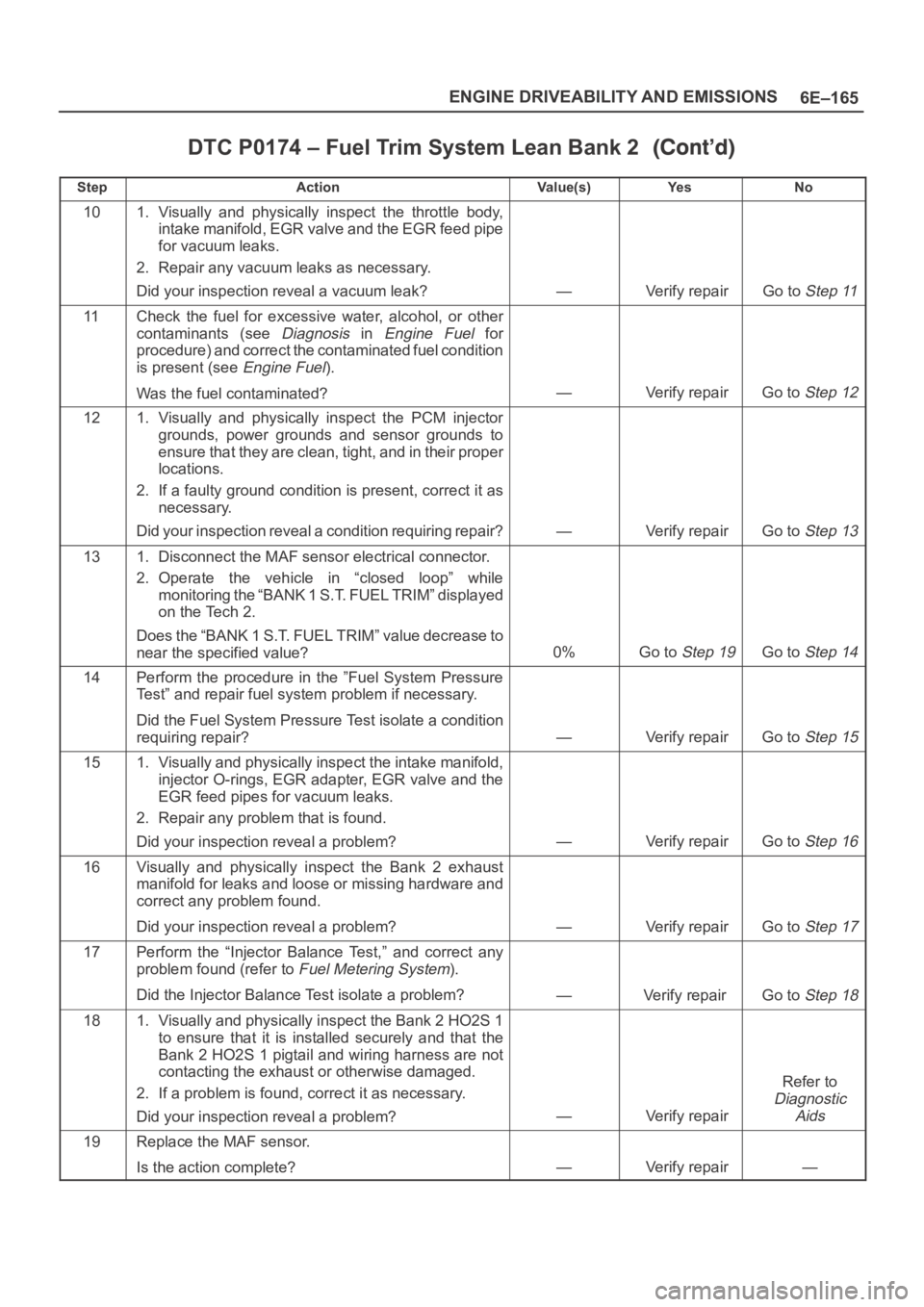
6E–165 ENGINE DRIVEABILITY AND EMISSIONS
DTC P0174 – Fuel Trim System Lean Bank 2
StepNo Ye s Va l u e ( s ) Action
101. Visually and physically inspect the throttle body,
intake manifold, EGR valve and the EGR feed pipe
for vacuum leaks.
2. Repair any vacuum leaks as necessary.
Did your inspection reveal a vacuum leak?
—Verify repairGo to Step 11
11Check the fuel for excessive water, alcohol, or other
contaminants (see
Diagnosis in Engine Fuel for
procedure) and correct the contaminated fuel condition
is present (see
Engine Fuel).
Was the fuel contaminated?
—Verify repairGo to Step 12
121. Visually and physically inspect the PCM injector
grounds, power grounds and sensor grounds to
ensure that they are clean, tight, and in their proper
locations.
2. If a faulty ground condition is present, correct it as
necessary.
Did your inspection reveal a condition requiring repair?
—Verify repairGo to Step 13
131. Disconnect the MAF sensor electrical connector.
2. Operate the vehicle in “closed loop” while
monitoring the “BANK 1 S.T. FUEL TRIM” displayed
on the Tech 2.
Does the “BANK 1 S.T. FUEL TRIM” value decrease to
near the specified value?
0%Go to Step 19Go to Step 14
14Perform the procedure in the ”Fuel System Pressure
Test” and repair fuel system problem if necessary.
Did the Fuel System Pressure Test isolate a condition
requiring repair?
—Verify repairGo to Step 15
151. Visually and physically inspect the intake manifold,
injector O-rings, EGR adapter, EGR valve and the
EGR feed pipes for vacuum leaks.
2. Repair any problem that is found.
Did your inspection reveal a problem?
—Verify repairGo to Step 16
16Visually and physically inspect the Bank 2 exhaust
manifold for leaks and loose or missing hardware and
correct any problem found.
Did your inspection reveal a problem?
—Verify repairGo to Step 17
17Perform the “Injector Balance Test,” and correct any
problem found (refer to
Fuel Metering System).
Did the Injector Balance Test isolate a problem?
—Verify repair Go to Step 18
181. Visually and physically inspect the Bank 2 HO2S 1
to ensure that it is installed securely and that the
Bank 2 HO2S 1 pigtail and wiring harness are not
contacting the exhaust or otherwise damaged.
2. If a problem is found, correct it as necessary.
Did your inspection reveal a problem?
—Verify repair
Refer to
Diagnostic
Aids
19Replace the MAF sensor.
Is the action complete?
—Verify repair—